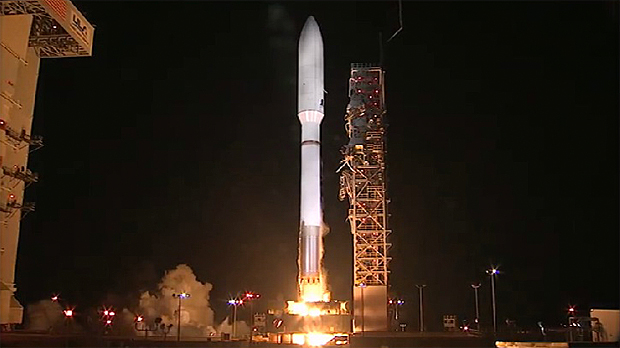Atlas 5 rocket carrying NRO spysat blasts off
12/06/2013 01:49 AM Filed in: Space News | Military Space
By WILLIAM HARWOOD
CBS News
A United Launch Alliance Atlas 5 rocket roared to life and climbed away from its California launch pad overnight Thursday, kicking off a classified mission to boost a National Reconnaissance Office spy satellite into orbit.
The powerful Russian-designed RD-180 engine at the base of the Atlas 5 ignited and throttled up at 11:14 p.m. PST (GMT-8), generating 860,000 pounds of thrust and lighting up the night sky with torrent of flame.
The towering rocket slowly climbed away from Space Launch Complex 3E on the California coast northwest of Los Angeles and arced away on a southerly trajectory toward an orbit around Earth's poles. Such polar orbits are favored by imaging spy satellites because the spacecraft pass over the entire planet as it rotates below.
While the payload was classified, the mission logo painted on the side of the rocket's payload fairing showed an octopus, arms extended around planet Earth, above the phrase "Nothing is Beyond Our Reach."
The climb to space appeared to go smoothly but as usual with such classified missions, commentary and video tracking ended about three-and-a-half minutes after liftoff, before the rocket's hydrogen-fueled Centaur second stage engine ignited.
The National Reconnaissance Office does not reveal the nature of its major payloads, but veteran space observers speculated the satellite launched aboard the Atlas 5 was an imaging radar spacecraft capable of around-the-clock observations regardless of lighting or cloud cover.
Two other such Boeing-built Future Imagery Architecture -- FIA -- radar satellites are believed to have been launched in 2010 and 2012. Plans for state-of-the-art optical FIA spysats were scrapped in 2005 because of technical problems and higher-than-expected costs.
The Atlas 5 Centaur second stage also carried a dozen small CubeSats, or "nanosatellites," into space in a pair of dispensers. The small, cube-shaped satellites were designed to carry out a variety of science and technoloy demonstration investigations ranging from advanced communications research to space weather observations and materials science.
CBS News
A United Launch Alliance Atlas 5 rocket roared to life and climbed away from its California launch pad overnight Thursday, kicking off a classified mission to boost a National Reconnaissance Office spy satellite into orbit.
The powerful Russian-designed RD-180 engine at the base of the Atlas 5 ignited and throttled up at 11:14 p.m. PST (GMT-8), generating 860,000 pounds of thrust and lighting up the night sky with torrent of flame.
 |
| A United Launch Alliance Atlas 5 rocket carrying a National Reconnaissance Office spy satellite blasts off from Vandenberg Air Force Base, Calif. (Credit: ULA webcast) |
The towering rocket slowly climbed away from Space Launch Complex 3E on the California coast northwest of Los Angeles and arced away on a southerly trajectory toward an orbit around Earth's poles. Such polar orbits are favored by imaging spy satellites because the spacecraft pass over the entire planet as it rotates below.
While the payload was classified, the mission logo painted on the side of the rocket's payload fairing showed an octopus, arms extended around planet Earth, above the phrase "Nothing is Beyond Our Reach."
The climb to space appeared to go smoothly but as usual with such classified missions, commentary and video tracking ended about three-and-a-half minutes after liftoff, before the rocket's hydrogen-fueled Centaur second stage engine ignited.
The National Reconnaissance Office does not reveal the nature of its major payloads, but veteran space observers speculated the satellite launched aboard the Atlas 5 was an imaging radar spacecraft capable of around-the-clock observations regardless of lighting or cloud cover.
Two other such Boeing-built Future Imagery Architecture -- FIA -- radar satellites are believed to have been launched in 2010 and 2012. Plans for state-of-the-art optical FIA spysats were scrapped in 2005 because of technical problems and higher-than-expected costs.
The Atlas 5 Centaur second stage also carried a dozen small CubeSats, or "nanosatellites," into space in a pair of dispensers. The small, cube-shaped satellites were designed to carry out a variety of science and technoloy demonstration investigations ranging from advanced communications research to space weather observations and materials science.